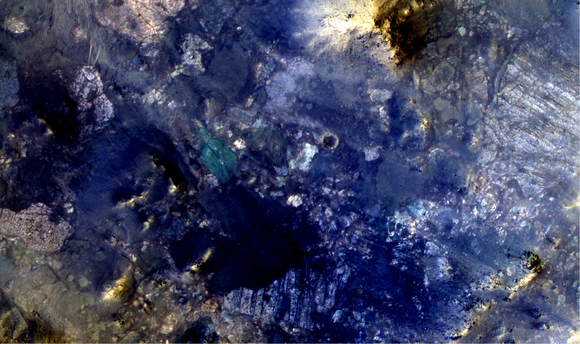Blue is my favorite color. Especially the shade of blue in the image for this week’s “Where In The Universe” challenge. It’s just such an uplifting color. But back to the challenge. The goal of this challenge is to test your skills and knowledge of our solar system. Guess where this image is from, and give yourself extra points if you can guess which spacecraft is responsible for the image. As always, don’t peek below before you make your guess. Comments on how you did are welcome.
Ready? Go!
This image was taken by the HiRISE Camera on the Mars Reconnaissance Orbiter. It shows the central uplift within an impact crater to the west of Nili Fossae on Mars. Planetary scientists love to see central uplifts, because they provide rare views of the rock types that exist miles beneath the modern-day surface of Mars. The impact process has shuffled different rock types into a disorganized array known as impact breccia.
This is an enhanced color image, to help discern between the different types of rock. Some of the materials that appear dark blue are probably patches of sand overlying the lighter-toned breccia.
Central uplifts are features that form on the floor of an impact crater shortly after the impact occurs. The crater’s central floor rebounds upward, forming a ring of hills and raising deeply buried rocks up to Martian surface. Infrared spectrometers such as THEMIS and CRISM have found that some of the rocks in this crater’s central uplift contain minerals that are intriguing and atypical for Mars, such as quartz, clays, and other water-bearing silicate minerals.
This image is just part of a larger swath taken by HiRISE. This portion of the image shows some of the central uplift rocks in fine detail. Blocks measuring from a few meters to over a hundred meters (10 to over 300 feet) across have coloration differences, suggesting that their compositions are different. Some of the largest blocks are internally layered, implying that they are blocks of sedimentary rock.
How did you do?
More about this image and to download a larger version in all its glory


I can’t believe I actually guessed the correct planet! The erosion features suggested a planet that had or has liquid flows, but the blue part looked too small to be an ocean, so I managed to guess Mars. Didn’t have a clue with the spacecraft, though.
Of course, it could be a lucky guess for the wrong reasons. ^_^;;
Yes! Nailed it.
Looked at it and thought to myself “hm… this looks like one of those HIRISE photos of Mars”. Is there extra points for guessing the *instrument*? 🙂
Jorge-
Sure! Give yourself extra points. Congrats!
Nancy
I was going to guess Earth, since it’s so often Earth, but then I saw the little crater. That and the smooth areas made me think it was the Moon.
I was guessing Earth as well, i got thrown off by the blue….. i was thinking maybe coral reefs in the caribean….. ugh…. wrong again…
Sigh. Wrong again. I guessed Titan. I had decided it was definitely not Mars because of the blue! D’OH!
Well, there’s always next week!
I guessed Callisto for some reason…boy was I waay off.
I sorta got it. I figured Venus or Mars but settled on Venus because of the white and blue colors seemed wrong for Mars. No fair! If it’s a false color image, we should be told what the colors represent! Since I’m grading myself, I’m gonna give me credit since I had trouble figuring which of my two choices was correct. I’m 9 for 11 I tell ya!
I feel embarrassed I was completely off. I guess Io. I didn’t even guess a planet.
I’ve never seen Mars in blue. My guess was Io, and the central uplift to be a volcano.
I’ll go to the corner. Obviously my grasp of planetary geology is utterly bad. 🙁
Yay! I correctly guessed the planet, spacecraft, and even the camera!
I agree that “not true color” at least should be mentioned. Spacecraft is one thing, but instrument changed color is a whole off-throw. Of course, I was just throwing off a wild guess of maybe Europa in a recently cratered and seldom seen rock point area, taken perhaps by Cassini in a recent fly-by.
Actually, I don’t think “not true color” is even remotely mandatory. For two reasons.
First of all, the vast majority of planet photos you see are not true color, even when they seem to be. Photos in space are shot to gather information, which means that they typically use very specific wavelengths scientists know (or hope) that will convey the most information about what they are photographing. Some of these photos are then processed to give us an approximation of true color but, since the wavelengths used are not our computers’ RGB values, they’ll be always just approximations.
And secondly, certain instruments produce consistently images in false color with some peculiar characteristics. Or the teams’ processing work follows a given pattern. That’s how I knew this was a HiRISE image: I had seen several other HiRISE images in blue tones much like these – used to better investigate the geological characteristics of Mars rocks – and since the topology was right for Mars, with craters, apparently layered rocks and dry flow structures, I found it pretty easy to decide on a subject, spacecraft AND camera.
False color images are cheating! I understand the scientific utility of false color images but they do NOT belong in this game. In my humble opinion.
i GUESSED!
Better, i found it:
Crater Central Uplift West of Nili Fossae (PSP_007464_1985)
The HIRISE camera.
First time for me!
Pedro
PS: I know it has been a few days but i only opened the email today